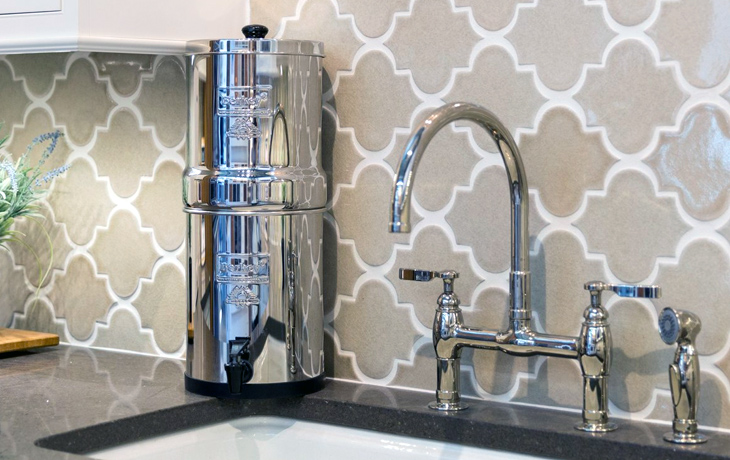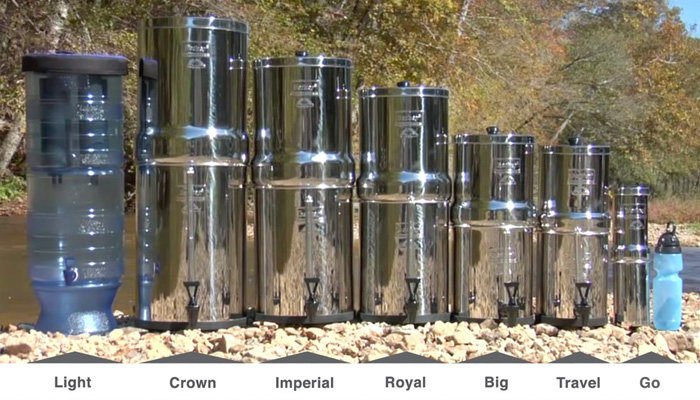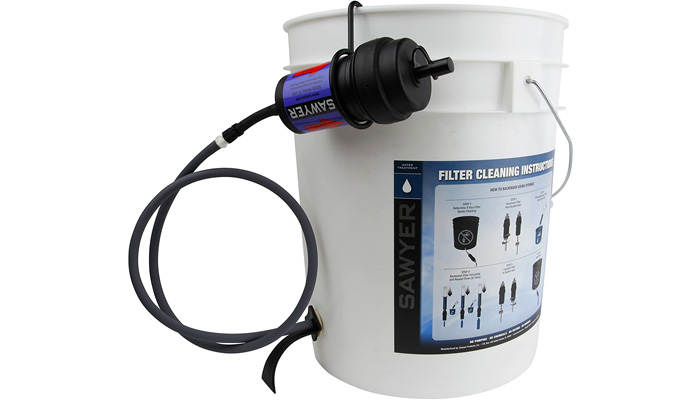When prepping, think of water treatment in two different categories:
- A small filter kept in a bug out bag or similar away-from-home kit, designed to keep you alive with small amounts of water wherever you are
- A filter kept at home, designed to more easily produce more water, more often
If you only buy one thing, make it a portable water filter. You can always use it around the house if you need to. Vice versa, you don’t want to have to carry your big Brita pitcher around if you happen to evacuate.
Review: Best portable water purification products and Best water canteens
This review covers the best water filters for your home.
Within the realm of home systems, there are two major types:
- “Point of use” filters that are stand-alone or easily added to a single faucet. The common Brita or PUR jugs seen at supermarkets are an example.
- “Point of entry” installed whole-house filters. These are larger systems that sit in between your main water source (grid or well) and the rest of your house piping/faucets.
Installed point-of-entry systems are great for always-on filtration throughout your home — just turn on the tap and get clean water.
But when we interviewed water quality expert Rick Andrews from NSF International, he pointed out that those systems are more expensive, take a lot more work to install, and typically have one fatal flaw for emergency preparedness: they can only take in water from your normal source/pipe.
One of the sane prepper rules is planning for the unknown and flexibility. So when thinking about this topic, you want to consider where you’ll get water in case your normal supply is tainted or unavailable and how you’ll treat it.
That means you can’t pour a bucket of lake water — or whatever else you can get your hands on: water heater, toilet tank, rain, etc. — into an installed system and get potable water out of the other end. That inflexibility could be bad in an emergency.
When shopping, remember:
- When thinking about your budget, keep filter replacement cost and frequency in mind. We’d rather have a product that’s slightly more expensive up front but lasts longer and doesn’t require expensive replacement filters every month (which is where those companies usually make most of their profit).
- Many “filters” only improve the taste of your water, not the safety. Be skeptical of marketing language — if it’s vague or sketchy, listen to your gut, particularly with cheap unknown brands on sites like Amazon.
- Filters remove physical particles, like bacteria and lead, but some contaminants are just too small or diluted to be caught and separated with a physical mesh screen. That’s when purification comes in (typically with UV, chemicals, or boiling).
- But a filter alone is almost always good enough to keep you safe.
- Don’t put water from an ocean or pool into these products. You’ll need special desalination equipment.
- When in doubt, only buy products certified by NSF International. Some products claim to be “tested to NSF standards”, which is not the same thing as actually being certified and thus can be gamed by unethical marketers.
- That said, some still-legit companies promote third-party testing from labs like Envirotek (sometimes known as the “Quality Filter Testing Laboratory”).
- You can make cheaper DIY versions if you don’t mind a little elbow grease. The best way is to use gravity to move water through a filter (like the Sawyer Mini) from one big container to another. Details at end of article.
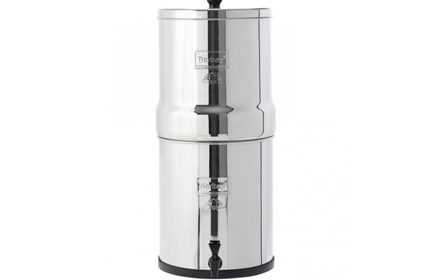
Popular for a reason:
Big Berkey Water Filter
The classic go-to for most preppers is the Big Berkey Gravity-Fed Water Filter. The Berkeys are a big jump in price compared to the budget options below — depending on size, $250-$700 compared to $50 — but many experts think the premium is worth it for a dedicated countertop filter.
Berkeys are gravity filters, which means you pour in water and gravity pulls it through the small filter pores (no water pressure or electricity needed!) So you fill the top tank, go about your business, and soon the bottom tank has clean water waiting to be used.
Berkeys come in sizes ranging from 1.5 to 6 gallons. The 2.25 gallon “Big” is the most common and recommended for households with 1-4 people. Here’s a guide and calculator for picking the right size.
We particularly like that Berkeys only need two filters to function (which are included) yet have room for up to four. That means you could keep four in for a longer time without maintenance or replacement — or, if SHTF, you can pull out two to set aside for the future and just run on the minimum two.
Berkey claims their cleanable filters last up to 6,000 gallons with a basic wipe-down once in a while — 10 times longer than competitors — but we’ve heard enough feedback from Berkey users to believe it’s not quite that durable.
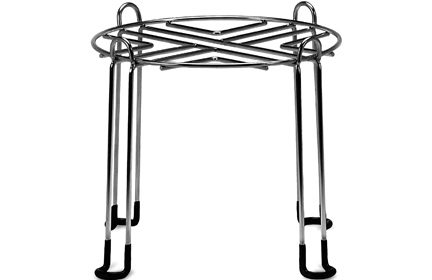
Great for countertops:
Impresa 8" countertop stand
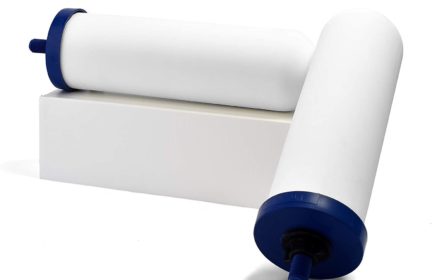
NSF Certified Filter:
Propur ProOne G2.0 9 inch Filter
The Berkeys are unfortunately not NSF certified. Although we prefer products that are, in this case we still recommend the Berkey because it’s been so widely used and tested, both by real people and third-party testing labs, that we’re comfortable with their claims. It’s usually a good sign when a manufacturer proactively shares their lab results, as Berkey does.
Note that their common Black filters don’t protect against fluoride. You’ll need the small PF2 add-on flouride filter for that.
If you want to stick only with filters that are NSF certified, the ProOne G2.0 9″ Filter Element from Propur is NSF/ANSI 42 certified and can work inside the Berkey bodies.
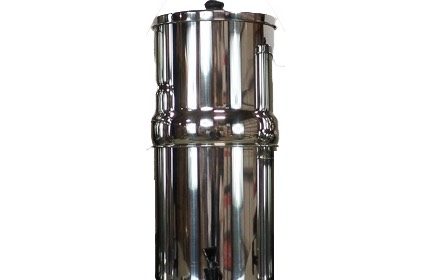
St. Paul Mercantile System
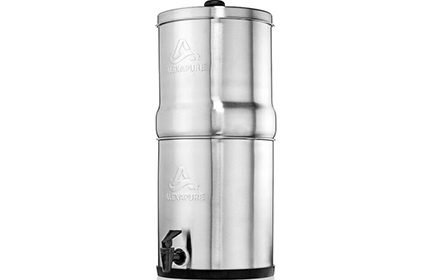
Alexapure Pro
We like the Berkey because it checks all the boxes: known brand, great filtration that covers almost everything, tested to exceed NSF standards, large enough to produce a lot of water yet still portable if you need to move it, and as a standalone unit it can take water from any source you find.
There are direct competitors to Berkey: the Alexapure Pro, Propur Nomad / Propur Big, and St. Paul Mercantile System. We haven’t had as much hands-on experience with these products as with the Berkey, but the lab results seem fine — so if you are struggling to find things in stock, any of these options should be okay. Here’s a full review of the cheaper St. Paul system.
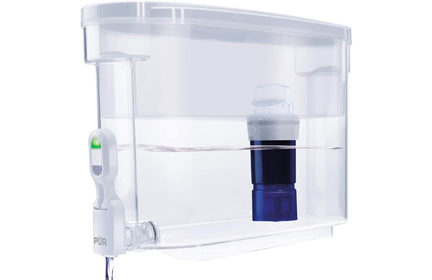
Best protection:
Pur Ultimate Dispenser
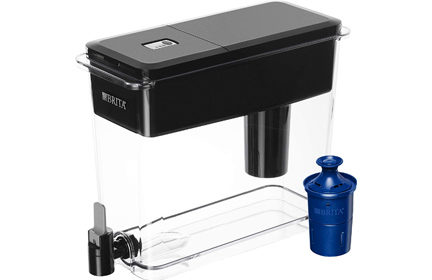
Cheaper and easier:
Brita Ultra Max
The best options under $50 (ish) come from well-known brands Brita and Pur. Both companies offer two relevant options: a tip-over “pitcher” style and a slightly larger “dispenser” style — both of which should fit in a normal fridge. We prefer (and link to above) the larger dispensers because of the extra capacity and form factor, but here’s the Pur 11-Cup Pitcher and Brita Everyday 10-Cup Pitcher.
Unfortunately, there’s not a clear winner among them. Pur easily beats Brita in terms of the number of contamination certifications, but the Longlast Brita filters last three times longer than the Pur ones — a logical tradeoff, given “stricter” filters will clog more quickly. Also, the Pur products tend to have lower reviews on the ancillary features like LED lights.
Pur’s top filter protects against lead, but the flow rate is much slower than the exact same filter without lead protection, which is still NSF-certified for a huge 22 contaminants. If you go with Brita, pick up the 14-certification Longlast filter — the basic Brita filter only has six certifications.
If you don’t want to spring for the expensive countertop models, but you do want better contamination protection, go with one of the Pur options. If you’re on a tight budget and want to minimize how often you need to replace a filter, go with Brita.
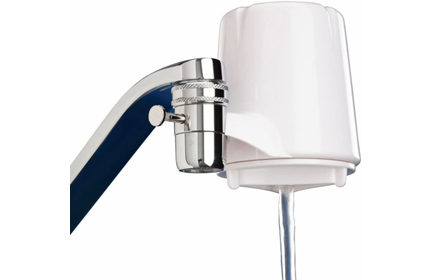
Culligan FM-15A Faucet Filter
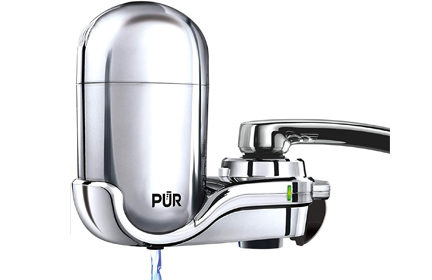
If you don’t want to bother with filling up a reservoir, the easiest option is to attach a filter right to the mouth of your faucet. There are two big tradeoffs, though: you can’t easily feed in wild water and the flow rate will be slow since the filtration is happening in real time.
One expert we interviewed pointed us to the NSF-certified Culligan FM-15A Faucet Mount Filter. It’s reportedly easy to install and can remove chlorine, lead, and VOCs (volatile organic compounds). The filter is good for 200 gallons, which should last 3-5 months in a typical home. Another very similar option is the slightly more expensive PUR Advanced faucet filter, which has consistently good reviews for ease of installation, but requires that the filter be replaced after 100 gallons.
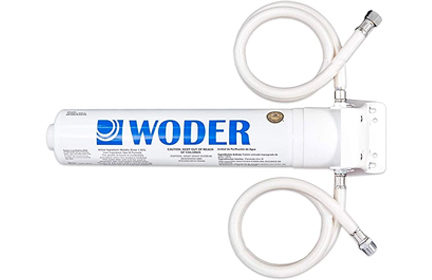
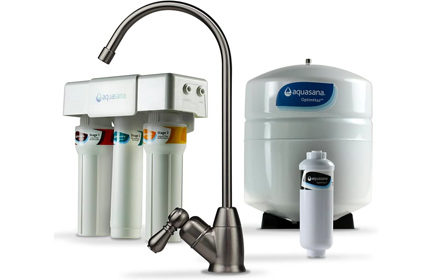
Complete faucet:
Aquasana OptimH2O
The Woder WD-S-8K-DC is an under-sink option that’s easy to install — you essentially just stick it in between your existing cold water hose and where that hose connects to your faucet. It’s NSF certified and reviews are generally positive.
The most permanent point-of-use style is a separate faucet installed next to your main one, with a filtration system under the counter/sink. Experts pointed us towards the reverse osmosis Aquasana OptimH20. The three-stage system may seem less robust on the surface compared to similarly-priced alternatives like the six-stage iSpring RCC7, but the Aquasana holds all possible NSF certifications for reverse osmosis filters and we favored it due to clearer testing documentation.
Be prepared. Don’t be a victim.
Want more great content and giveaways? Sign up for The Prepared’s free newsletter and get the best prepping content straight to your inbox. 1-2 emails a month, 0% spam.
Common contaminants
Keep in mind that safe drinking water doesn’t have to only be two parts hydrogen and one part oxygen.
Some additives, like chlorine and fluoride, are typically believed to be a good thing — small amounts of chlorine keep your water and pipes clear of germs while fluoride is added to help prevent tooth decay.
You can choose to remove those compounds, but you’ll lose the benefits. (No, conspiracy theorists, there is not a global conspiracy with fluoride in water.)
NSF International has an in-depth list of contaminants and products they’ve tested for each. A few of the worst ones:
- Bacteria, viruses, and other microorganisms. The worst of these is E.coli and Cryptosporidium, which can cause severe illness or death for vulnerable populations.
- Chlorine. Some amount is good, but too much can cause skin irritation or make the water taste like a pool.
- Nitrates. Chemicals commonly found in fertilizers, manure, and liquid waste from plumbing systems and septic tanks. Nitrate consumption can cause a number of health problems, and is particularly dangerous for infants because it can lead to “baby blue” disease, which inhibits oxygen in blood flow.
- Arsenic. A metallic substance that occurs naturally from mineral deposits or (more commonly) comes from contact with hazardous industrial waste. Health problems can be severe, including skin problems, digestive issues, and limb numbness.
- Aluminum. Low levels aren’t harmful (it can actually help kill things like E.coli), but high levels can affect the nervous system with links to Parkinson’s, Alzheimer’s, and Lou Gehrig’s diseases. Can also lead to kidney damage and anemia.
- Lead. No amount is safe to consume. Typically enters water through contact with old plumbing materials like pipes and faucets. Most common in homes built before 1986.
- Volatile Organic Compounds (VOCs). According to the EPA, VOCs are present in 20% of the U.S. water supply and can enter from a variety of sources. A few examples of VOCs are benzene, which can enter groundwater from gasoline or oil spills; dichloromethane, an industrial solvent; trichloroethylene, used in septic system cleaners; and tetrachloroethylene (perchloroethylene), used in the dry-cleaning industry.
How to find out what’s in your local water
If you want to use a home water filter in your daily life — not just during emergencies — it might be helpful to know what your local risks are so you can tailor your system to your needs. Or you can choose to skip the tests and just get the most protection you reasonably can.
If you’re on a municipal supply, try calling your local water service to ask for the annual quality report. They’re often required by law to share the info. Some cities even mail out the annual report to every homeowner.
If you’re on a private supply or don’t trust the official reports, you’ll need to hire or perform a test. Local companies can help or you can try a service like Tap Score where you send a sample to a lab for testing. Those tests will typically be $100 and up.
National standards and ratings
The standard reference for rating a home water filter system comes from NSF International. If a filter system doesn’t have an NSF mark, you can’t be sure of its effectiveness.
An NSF certified filter system will have the NSF mark along with numbers such as NSF/ANSI 53 or NSF/ANSI 42, which refer to the standard to which the filter has been certified. Some of the NSF standards applicable to water treatments are standard 41 (taste and odor), 53 (cyst reduction), 58 (reverse osmosis), and 62 (distillation). Here’s a full list.
For example: NSF International says that when it comes to sourcing water from a lake or river, the recommendation would be to use a UV system or a product certified to NSF/ANSI 55 Class A.
If it’s certified by NSF, that means it satisfies the following criteria:
- Contaminant reduction claims are verified
- System tested to verify nothing harmful is added to the water
- Verified to be structurally sound
- Advertising, literature, and labeling are accurate
- Tested to verify that materials and production processes haven’t changed over time
DIY methods
The filters in these home products aren’t all that different than the portable filters we recommend for go-bags — the main difference is form factor.
For example, the Berkey is similar to the multi-pouch gravity kits carried in a go-bag, just put into a rigid stainless steel frame for ease of use at home and with larger quantities of water.
Which means you could save money by piecing a similar system together yourself. The Sawyer Point ZeroTwo Bucket System, for example, is essentially the same filter you’d use in a go-bag, just with extra hoses and pieces so you can connect the filter between a dirty water bucket and a clean container — as long as the dirty bucket is higher than the rest, gravity will do the work. That could work as a hacky home filter setup.
Review: Sawyer Point ZeroTwo System
There are less-convenient methods for creating clean water at home, which are usually some form of distillation where you heat the dirty water then collect and recondense the “clean” steam.
Some of those methods are very DIY, such as the above method using a pot over a kitchen stove, BBQ grill, or camp fire, or you can buy a proper product like an alcohol still. Although it’s essentially a purifier, not a filter, since it removes everything except pure H20 (including salt) via evaporation. Boiled water in a larger container creates steam which is funneled through and condensed in a pipe and slowly drips out pure distilled water. The downsides are that it is incredibly slow and the need to spend fuel heating the water. So while it works, it tends to be an inferior choice unless you’re limited to salty or other hard-to-filter water, or need something that can theoretically last forever.
